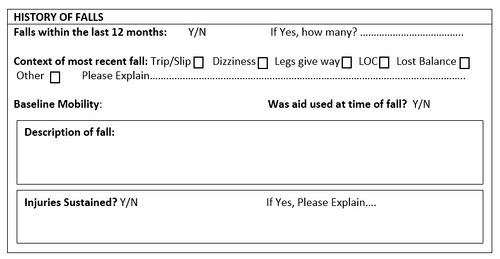Rumored Buzz on Dementia Fall Risk
Rumored Buzz on Dementia Fall Risk
Blog Article
The 7-Minute Rule for Dementia Fall Risk
Table of ContentsDementia Fall Risk for BeginnersGetting My Dementia Fall Risk To WorkRumored Buzz on Dementia Fall RiskThe Only Guide for Dementia Fall RiskThe Definitive Guide for Dementia Fall Risk
Assessing autumn threat aids the entire health care team develop a safer atmosphere for every client. Guarantee that there is a designated area in your medical charting system where staff can document/reference scores and document appropriate notes connected to fall prevention. The Johns Hopkins Autumn Risk Analysis Device is among numerous devices your personnel can utilize to help prevent damaging clinical events.Person drops in hospitals prevail and incapacitating adverse occasions that persist despite years of effort to decrease them. Improving communication throughout the evaluating registered nurse, care group, individual, and patient's most included family and friends may reinforce autumn avoidance efforts. A team at Brigham and Female's Healthcare facility in Boston, Massachusetts, looked for to establish a standard fall avoidance program that focused around improved interaction and client and family interaction.

The advancement group highlighted that effective implementation depends upon patient and personnel buy-in, integration of the program right into existing workflows, and fidelity to program processes. The group kept in mind that they are coming to grips with just how to make sure connection in program implementation throughout periods of situation. During the COVID-19 pandemic, for instance, a rise in inpatient falls was related to limitations in individual engagement together with constraints on visitation.
Some Known Facts About Dementia Fall Risk.
These occurrences are generally taken into consideration preventable. To carry out the treatment, organizations need the following: Access to Fall TIPS sources Fall TIPS training and retraining for nursing and non-nursing personnel, including new nurses Nursing workflows that enable patient and family members interaction to perform the drops evaluation, make sure use of the avoidance strategy, and conduct patient-level audits.
The results can be extremely harmful, commonly speeding up client decline and causing longer healthcare facility remains. One study estimated stays increased an additional 12 in-patient days after a client loss. The Fall TIPS Program is based on engaging clients and their family/loved ones across 3 main processes: analysis, personalized preventative interventions, and bookkeeping to make sure that clients are taken part in the three-step fall avoidance procedure.
The patient evaluation is based on the Morse Fall Scale, which is a confirmed autumn risk evaluation tool for in-patient medical facility settings. The range includes the 6 most typical factors individuals in health centers fall: the person autumn background, high-risk problems (including polypharmacy), use IVs and other outside devices, psychological status, gait, and movement.
Each threat factor web links with several workable evidence-based interventions. The registered nurse creates a plan that includes the interventions and shows up to the treatment team, individual, and family members on a laminated poster or printed aesthetic help. Nurses create the plan while fulfilling with the patient and the individual's family members.
Dementia Fall Risk - An Overview
The poster serves as an interaction device with other members of the individual's care group. Dementia Fall Risk. The audit part of the program consists of assessing the client's understanding of their danger variables and avoidance plan at the unit and medical facility levels. Nurse champs perform at the very least 5 specific meetings a month with patients and their households to examine for understanding of the fall avoidance strategy

An estimated 30% of these falls result in injuries, which can vary in seriousness. Unlike other negative events that call for a standardized scientific response, loss prevention depends very on the requirements of the person.
Not known Facts About Dementia Fall Risk

Based on bookkeeping results, one website had 86% conformity and two websites had more than 95% compliance. A cost-benefit evaluation of the Loss suggestions program in 8 healthcare facilities approximated that the program cost $0.88 per person to execute and led to savings of $8,500 per 1000 patient-days in direct expenses associated to the avoidance of 567 tips over three years and 8 months.
According to the innovation team, companies curious about executing the program ought to conduct a readiness evaluation and drops avoidance voids evaluation. 8 Additionally, organizations ought to make sure the necessary infrastructure and workflows for application and establish an execution strategy. If one exists, the company's Fall Prevention Task Force ought to be included in preparation.
Getting The Dementia Fall Risk To Work
To begin, organizations should ensure completion of training modules by registered nurses and nursing assistants - Dementia Fall Risk. Healthcare facility staff Learn More ought to examine, based on the needs of a health center, whether to make use of a digital health and wellness record hard copy or paper version of the autumn avoidance strategy. Carrying out teams ought to hire and educate registered nurse champions and develop procedures for bookkeeping and reporting on fall information
Personnel require to be associated with the procedure of revamping the process to involve individuals and family in the assessment and prevention plan process. Solution needs to remain in location to ensure that units can comprehend why an autumn occurred and remediate the cause. A lot more especially, nurses must have networks to provide ongoing comments to both personnel and device management so they can change and boost loss prevention process and communicate systemic issues.
Report this page